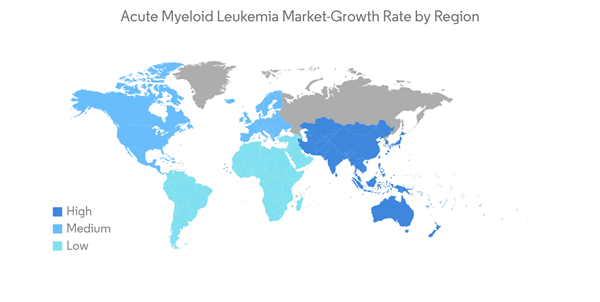The Acute Myeloid Leukemia Market size is estimated at USD 1.83 billion in 2024, and is expected to reach USD 2.97 billion by 2029, growing at a CAGR of 10.15% during the forecast period (2024-2029).
The COVID-19 pandemic has significantly impacted the acute myeloid leukemia market. Cancer treatments such as chemotherapy and immune suppressants damage the patient's immune system. This weakened immune system of the target population is expected to create a risk of Covid-19 infection. Various research was conducted to find the impact of Covid 19 on AML patients. According to the National Cancer Institute (NCI), in August 2021, people with cancer had a higher risk of severe illness from COVID-19.
Furthermore, according to an article published by the American Society of Hematology, in January 2022, due to anticipated shortfalls in blood bank supplies during the COVID-19 pandemic, blood transfusion thresholds were lowered while taking into account significant local/regional variability. Patients who tested positive for COVID-19 had got their treatment delayed. Since newly discovered AML is a treatment-emergent, intensive induction chemotherapy was made available to eligible AML patients. Thus, increased risk for an AML in a pandemic and the shortage of other treatment modalities are expected to drive the demand for AML drugs.
The key factors propelling the growth of this market are the high incidence and prevalence of acute myeloid leukemia, advancements in pharmacology and molecular biology to promote drug development, and increasing investments in research and development by pharmaceutical companies. According to the American Cancer Society, it is estimated that there will be 60,650 new leukemia cancer cases, of which 24,000 are expected to die in 2022 in the US. In addition, according to the same source, 20,050 new cases of acute myeloid leukemia (AML) are estimated in 2022 in the US. It will lead to increased adoption of AML therapies. The rising prevalence of AML in developed countries such as the US is expected to drive this market's growth.
Furthermore, with the rising investment in research and development, there is an increasing number of clinical trials conducted to demonstrate the effectiveness of the drugs. It is expected to drive the market over the forecast period. For Instance, according to the United States National Library of Medicine, a study titled 'Daunorubicin or Idarubicin With Cytarabine Plus Quizartinib vs. Physician's Choice in Newly Diagnosed FLT3-ITD+ AML (Q-SOC)' is in Phase III of clinical trials. The study was estimated to start in November 2021 and be complete in March 2025.
Thus, the abovementioned factors are impacting the market growth of the Acute myeloid leukemia market. However, stringent regulations on drugs and complications related to chemotherapy are the factors expected to restrain the market growth.
Rising approvals for Cytarabine by the US Food and Drug Administration for treating acute myeloid leukemia are also expected to drive the growth of this market. For Instance, in March 2021, Jazz Pharmaceuticals PLC received US Food and Drug Administration (FDA) approval for a revised label for Vyxeos (daunorubicin and Cytarabine), including a new indication to treat newly-diagnosed therapy-related acute myeloid leukemia (t-AML) or AML with myelodysplasia-related changes (AML-MRC) in pediatric patients aged one year and older. Furthermore, in January 2022, the US Food and Drug Administration (FDA) granted the company orphan drug designation for its pipeline compound OM-301 to treat acute myeloid leukemia (AML) developed by Oncolyze Inc. These approvals from the regulatory authorities are driving the growth of the market.
Therefore, owing to the abovementioned factors, the cytarabine segment is expected to show a significant share during the forecast period.
Furthermore, rising research and development and product launches for acute myeloid leukemia are further expected to drive market growth in this region. For instance, in May 2022, the FDA approved ivosidenib (Tibsovo, Servier Pharmaceuticals LLC) in combination with azacitidine (azacitidine for injection) for newly diagnosed acute myeloid leukemia (AML). It includes a susceptible IDH1 mutation detected by an FDA-approved test in adults 75 years or older or with comorbidities that preclude intensive induction chemotherapy.
Therefore, the market is expected to show a significant share in North America due to the abovementioned factors.
This product will be delivered within 2 business days.
The COVID-19 pandemic has significantly impacted the acute myeloid leukemia market. Cancer treatments such as chemotherapy and immune suppressants damage the patient's immune system. This weakened immune system of the target population is expected to create a risk of Covid-19 infection. Various research was conducted to find the impact of Covid 19 on AML patients. According to the National Cancer Institute (NCI), in August 2021, people with cancer had a higher risk of severe illness from COVID-19.
Furthermore, according to an article published by the American Society of Hematology, in January 2022, due to anticipated shortfalls in blood bank supplies during the COVID-19 pandemic, blood transfusion thresholds were lowered while taking into account significant local/regional variability. Patients who tested positive for COVID-19 had got their treatment delayed. Since newly discovered AML is a treatment-emergent, intensive induction chemotherapy was made available to eligible AML patients. Thus, increased risk for an AML in a pandemic and the shortage of other treatment modalities are expected to drive the demand for AML drugs.
The key factors propelling the growth of this market are the high incidence and prevalence of acute myeloid leukemia, advancements in pharmacology and molecular biology to promote drug development, and increasing investments in research and development by pharmaceutical companies. According to the American Cancer Society, it is estimated that there will be 60,650 new leukemia cancer cases, of which 24,000 are expected to die in 2022 in the US. In addition, according to the same source, 20,050 new cases of acute myeloid leukemia (AML) are estimated in 2022 in the US. It will lead to increased adoption of AML therapies. The rising prevalence of AML in developed countries such as the US is expected to drive this market's growth.
Furthermore, with the rising investment in research and development, there is an increasing number of clinical trials conducted to demonstrate the effectiveness of the drugs. It is expected to drive the market over the forecast period. For Instance, according to the United States National Library of Medicine, a study titled 'Daunorubicin or Idarubicin With Cytarabine Plus Quizartinib vs. Physician's Choice in Newly Diagnosed FLT3-ITD+ AML (Q-SOC)' is in Phase III of clinical trials. The study was estimated to start in November 2021 and be complete in March 2025.
Thus, the abovementioned factors are impacting the market growth of the Acute myeloid leukemia market. However, stringent regulations on drugs and complications related to chemotherapy are the factors expected to restrain the market growth.
Acute Myeloid Leukemia Market Trends
Cytarabine is Expected to Witness High Growth Over the Forecast Period
Cytarabine can treat different leukemia forms, including acute and chronic myelogenous leukemia (AML and CML), acute lymphocytic leukemia (ALL), and acute promyelocytic leukemia (APL). It can also treat Hodgkin's lymphoma, meningeal leukemia, and other types of lymphoma (cancers found in the lining of the brain and spinal cord). Due to its effectiveness in treating acute myeloid leukemia, Cytarabine is widely used during chemotherapy. Organizations working for cancer, such as Macmillan Cancer Support, have stated that Cytarabine is more effective for acute myeloid leukemia, which is why the drug is used widely. Therefore, this sub-segment is expected to have a significant market share in the chemotherapy segment.Rising approvals for Cytarabine by the US Food and Drug Administration for treating acute myeloid leukemia are also expected to drive the growth of this market. For Instance, in March 2021, Jazz Pharmaceuticals PLC received US Food and Drug Administration (FDA) approval for a revised label for Vyxeos (daunorubicin and Cytarabine), including a new indication to treat newly-diagnosed therapy-related acute myeloid leukemia (t-AML) or AML with myelodysplasia-related changes (AML-MRC) in pediatric patients aged one year and older. Furthermore, in January 2022, the US Food and Drug Administration (FDA) granted the company orphan drug designation for its pipeline compound OM-301 to treat acute myeloid leukemia (AML) developed by Oncolyze Inc. These approvals from the regulatory authorities are driving the growth of the market.
Therefore, owing to the abovementioned factors, the cytarabine segment is expected to show a significant share during the forecast period.
North America Holds a Major Share and Expected to do Same during the Forecast Period
North America currently dominates the market for acute myeloid leukemia and is expected to continue its stronghold over the forecast period. The rising prevalence of acute myeloid leukemia cases in the US is expected to drive the growth of this market in this region. For instance, according to the American Society of Clinical Oncology in 2021, acute myeloid leukemia is a rare malignancy that accounts for around 1% of all cancers. In the US, an estimated 20,240 people of all ages (11,230 men and boys and 9,010 women and girls) were diagnosed with this disease in 2021. AML is the second most prevalent kind of leukemia in adults and children, with adults accounting for the majority of occurrences. Therefore, the rising prevalence of acute myeloid leukemia in the US will lead to higher therapy adoption for this disease, thereby expected to drive the growth of this market in North America.Furthermore, rising research and development and product launches for acute myeloid leukemia are further expected to drive market growth in this region. For instance, in May 2022, the FDA approved ivosidenib (Tibsovo, Servier Pharmaceuticals LLC) in combination with azacitidine (azacitidine for injection) for newly diagnosed acute myeloid leukemia (AML). It includes a susceptible IDH1 mutation detected by an FDA-approved test in adults 75 years or older or with comorbidities that preclude intensive induction chemotherapy.
Therefore, the market is expected to show a significant share in North America due to the abovementioned factors.
Acute Myeloid Leukemia Industry Overview
The acute myeloid leukemia market is consolidated in nature due to the presence of a few companies operating globally as well as regionally. The competitive landscape includes an analysis of a few international and local companies that hold market shares and are well known, including Novartis AG, Teva Pharmaceuticals, Pfizer, Bristol Myer Squibb, and Sanofi-Aventis (Genzyme Corporation), among others.Additional Benefits:
- The market estimate (ME) sheet in Excel format
- 3 months of analyst support
This product will be delivered within 2 business days.
Table of Contents
1 INTRODUCTION
4 MARKET DYNAMICS
5 MARKET SEGMENTATION (Market Size by Value - USD million)
6 COMPETITIVE LANDSCAPE
Companies Mentioned (Partial List)
A selection of companies mentioned in this report includes, but is not limited to:
- Bristol-Myers Squibb Company (Celgene Corporation)
- Novartis AG
- Genmab AS
- Otsuka Holdings Co. Ltd
- Sanofi-Aventis (Genzyme Corporation)
- Teva Pharmaceutical (Cephalon Inc.)
- Pfizer Inc.
- F. Hoffmann-La Roche Ltd
- Sunesis Pharmaceuticals Inc.
- Astellas Pharma
- Oncolyze Inc.
- Syndax Pharmaceuticals Inc.
- AbbVie Inc.
- Amgen Inc.
- Agios Pharmaceuticals Inc.
Methodology

LOADING...










